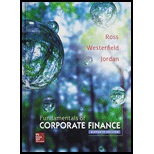
Concept explainers
Systematic versus Unsystematic Risk [LO3] Consider the following information about Stocks I and II:
![Chapter 13, Problem 26QP, Systematic versus Unsystematic Risk [LO3] Consider the following information about Stocks I and II:](http://dev-ingestion-image-output.s3-website-us-east-1.amazonaws.com/9780077861704/Chapter-13/images/61704-13-26qp-question-digital_image_001.png)
The market risk premium is 7 percent, and the risk-free rate is 4 percent. Which stock has the most systematic risk? Which one has the most unsystematic risk? Which stock is “riskier”? Explain.
To determine: The stock that has the most systematic risk and most unsystematic risk.
Introduction:
Systematic risk refers to the market-specific risk that affects all the stocks in the market. Unsystematic risk refers to the company-specific risk that affects only the individual company.
Answer to Problem 26QP
The expected return on Stock I is 15.90 percent, the beta is 1.70, and the standard deviation is 7.87%. The expected return on Stock II is 9.15 percent, the beta is 0.74, and the standard deviation is 18.90%.
The beta refers to the systematic risk of the stock. Stock I has higher beta than Stock II. Hence, the systematic risk of Stock I is higher. The standard deviation indicates the total risk of the stock. The standard deviation is high for Stock II despite having a low beta. Hence, a major portion of the standard deviation of Stock II is the unsystematic risk.
Stock II has higher unsystematic risk than Stock I. The formation of a portfolio helps in diversifying the unsystematic risk. Although Stock II has a higher unsystematic risk, it can be diversified completely. However, the beta cannot be eliminated. Hence, Stock I is riskier than Stock II.
The expected return and the market risk premium depends on the beta of the stock. As Stock I has a higher beta, the expected return and market risk premium of the stock will be higher than Stock II.
Explanation of Solution
Given information:
The probability of having a recession, normal economy, and irrational exuberance is 0.15, 0.70, and 0.15 respectively. Stock I will yield 2%, 21%, and 6% when there is a recession, normal economy, and irrational exuberance respectively.
Stock II will yield (25%), 9%, and 44% when there is a recession, normal economy, and irrational exuberance respectively. The market risk premium is 7% and the risk-free rate is 4%.
The formula to calculate the expected return on the stock:
The formula to calculate the beta of the stock:
Where,
“E (Ri)” refers to the expected return on a risky asset
“Rf” refers to the risk-free rate
“E (RM)” refers to the expected return on the market portfolio
“βi” refers to the beta coefficient of the risky asset relative to the market portfolio
The formula to calculate the standard deviation:
Compute the expected return on Stock I:
“R1” is the returns during the recession. The probability of having a recession is “P1”. Similarly, “R2” is the returns in a normal economy. The probability of having a normal is “P2”. “R3” is the returns in irrational exuberance. The probability of having an irrational exuberance is “P3”.
Hence, the expected return on Stock I is 15.90 percent.
Compute the beta of Stock I:
Hence, the beta of Stock I is 1.70.
Compute the standard deviation of Stock I:
“R1” is the returns during the recession. The probability of having a recession is “P1”. Similarly, “R2” is the returns in a normal economy. The probability of having a normal is “P2”. “R3” is the returns in irrational exuberance. The probability of having an irrational exuberance is “P3”.
Hence, the standard deviation of Stock I is 7.87%.
Compute the expected return on Stock II:
“R1” is the returns during the recession. The probability of having a recession is “P1”. Similarly, “R2” is the returns in a normal economy. The probability of having a normal is “P2”. “R3” is the returns in irrational exuberance. The probability of having an irrational exuberance is “P3”.
Hence, the expected return on Stock II is 9.15 percent.
Compute the beta of Stock II:
Hence, the beta of Stock II is 0.74.
Compute the standard deviation of Stock II:
“R1” is the returns during the recession. The probability of having a recession is “P1”. Similarly, “R2” is the returns in a normal economy. The probability of having a normal is “P2”. “R3” is the returns in irrational exuberance. The probability of having an irrational exuberance is “P3”.
Hence, the standard deviation of Stock II is 18.90%.
Want to see more full solutions like this?
Chapter 13 Solutions
Fundamentals of Corporate Finance with Connect Access Card
- How do you calculate the intrinsic value of a stock using the dividend discount model (DDM)? i need coarrow_forwardHow do you calculate the intrinsic value of a stock using the dividend discount model (DDM)?arrow_forwardHow does the weighted average cost of capital (WACC) affect a company’s valuation? i need help in this qarrow_forward
- How does the weighted average cost of capital (WACC) affect a company’s valuation?i need correct answer.arrow_forwardHow does the weighted average cost of capital (WACC) affect a company’s valuation?i need help.arrow_forwardHow does the weighted average cost of capital (WACC) affect a company’s valuation? Need helparrow_forward
 Intermediate Financial Management (MindTap Course...FinanceISBN:9781337395083Author:Eugene F. Brigham, Phillip R. DavesPublisher:Cengage Learning
Intermediate Financial Management (MindTap Course...FinanceISBN:9781337395083Author:Eugene F. Brigham, Phillip R. DavesPublisher:Cengage Learning EBK CONTEMPORARY FINANCIAL MANAGEMENTFinanceISBN:9781337514835Author:MOYERPublisher:CENGAGE LEARNING - CONSIGNMENT
EBK CONTEMPORARY FINANCIAL MANAGEMENTFinanceISBN:9781337514835Author:MOYERPublisher:CENGAGE LEARNING - CONSIGNMENT Financial Reporting, Financial Statement Analysis...FinanceISBN:9781285190907Author:James M. Wahlen, Stephen P. Baginski, Mark BradshawPublisher:Cengage Learning
Financial Reporting, Financial Statement Analysis...FinanceISBN:9781285190907Author:James M. Wahlen, Stephen P. Baginski, Mark BradshawPublisher:Cengage Learning


